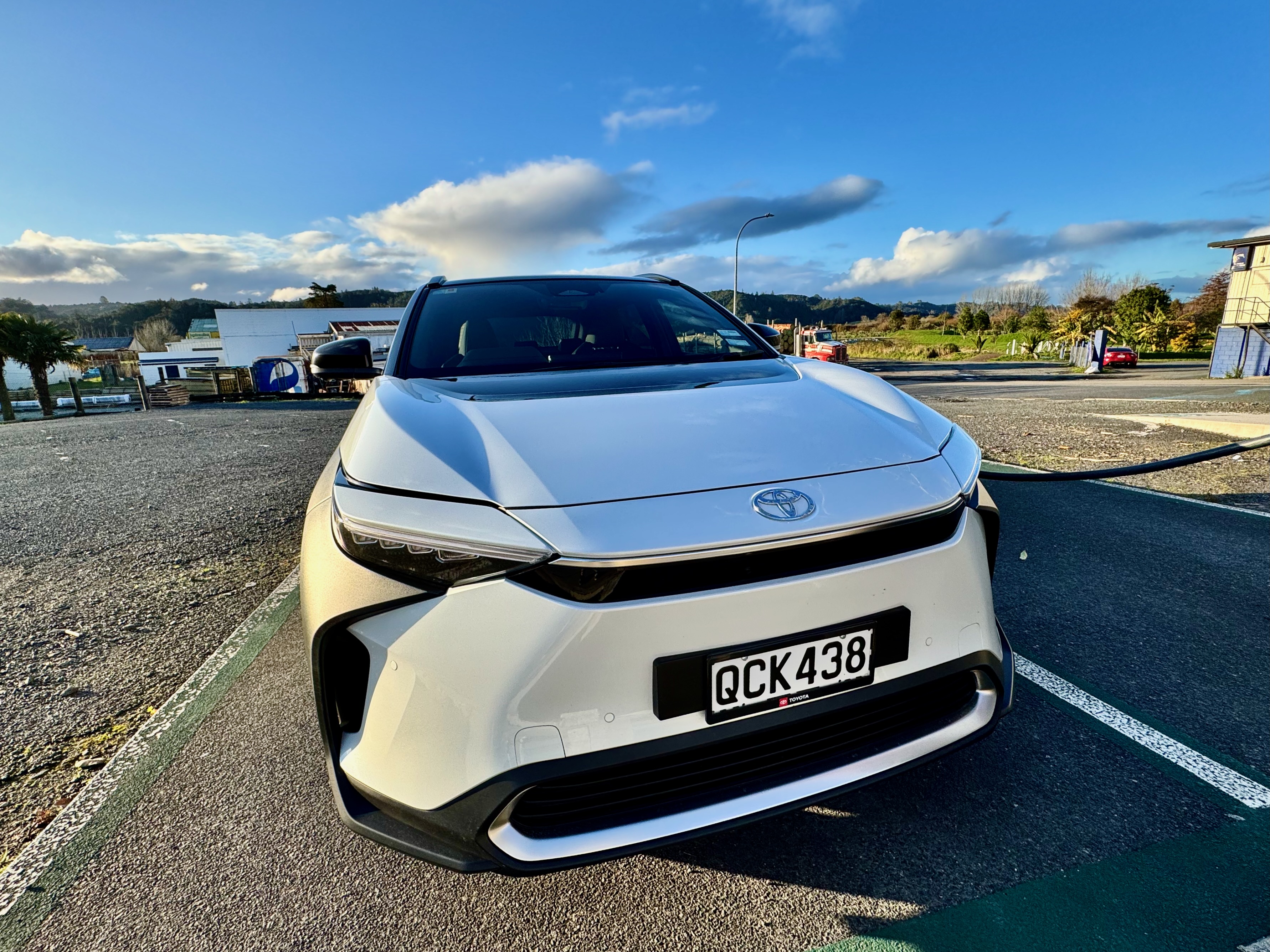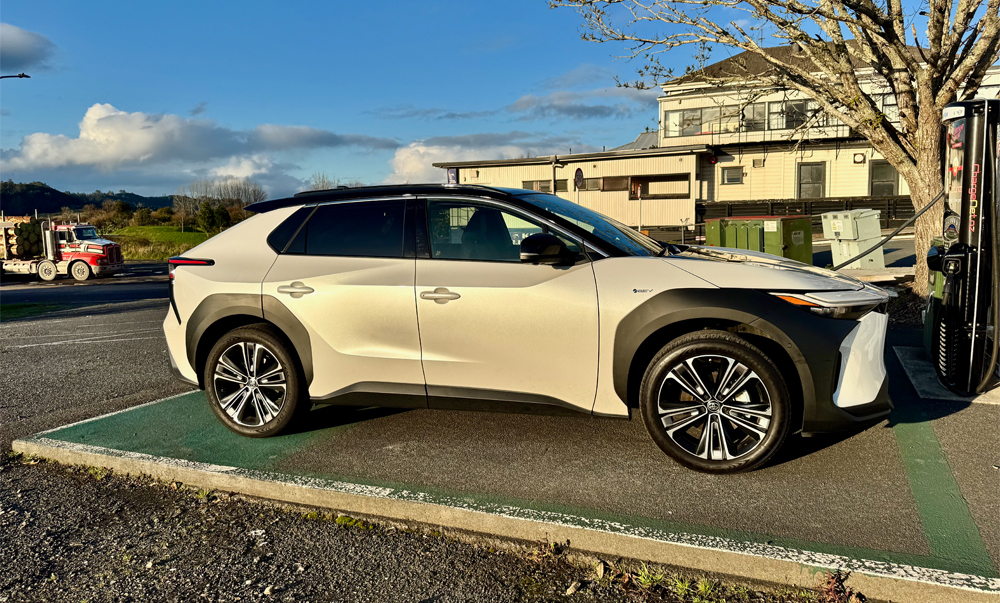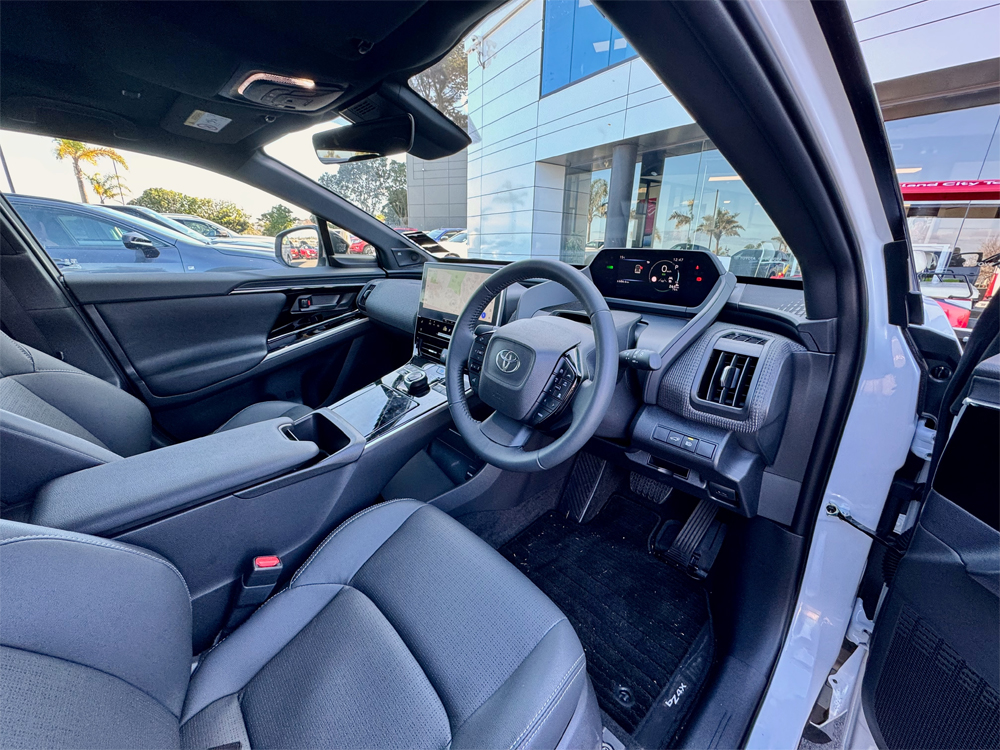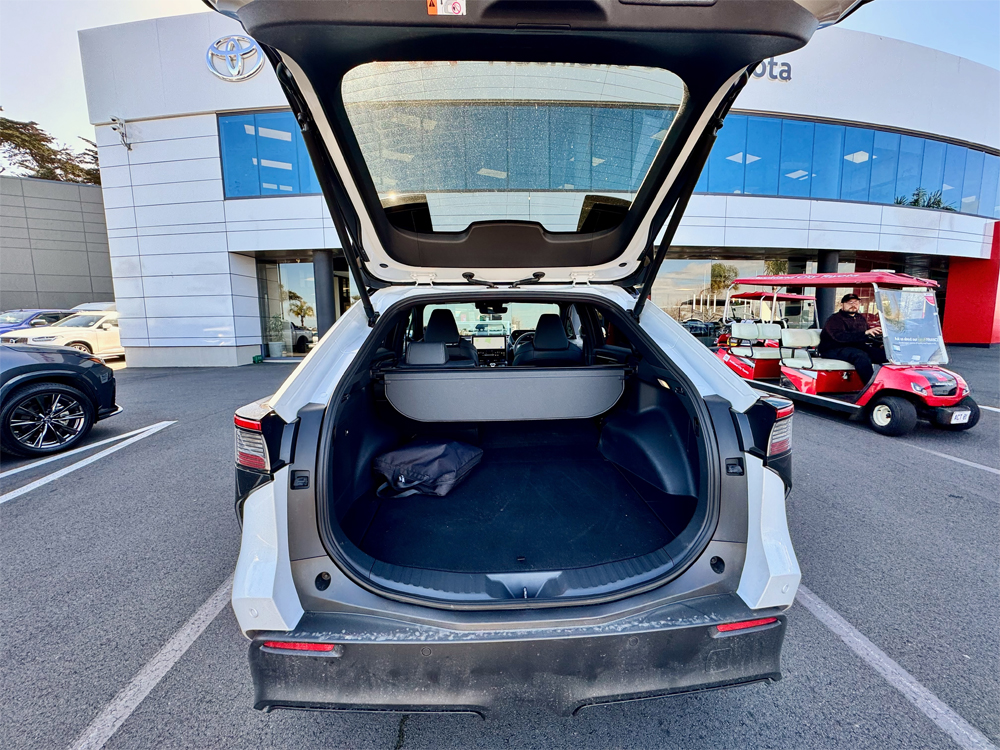
All right, so the timing of this piece isn't the best, what with the nation being angsty about electricity prices going up again. We could segue into whether or not it was the Bradford Reforms causing the price hikes, but let's not. It upsets Max to have his name attached to them.
Anyway, Toyota had the fully electric bZ4X available for a test drive so ignoring the electricity issues, behind the steering wheel yours truly went, setting off in the white Motion spec vehicle that costs $83,990 with two-tone paint optioned.
This is Toyota's first fully electric car, with seven other models promised for 2026.
It's not a cheap car in other words but the pricier Motion variant is the one to go for instead of the lower-spec Pure version, which is about ten grand less.
The added $10k for the Motion buys all-wheel drive instead of front-wheel drive, with two 80 kilowatt motors driving each axle, instead of a single engine. Output goes up to 160 kW in the Motion vis-à-vis 150 kW in the Pure. Each motor produces 168 Newton metres of torque in the Motion; apparently you can't just double that figure, but it'll be more than the 266 Nm that the Pure has.

Motion also adds a panoramic roof, JBL audio (that sounds pretty good), the X-Mode settings with snow/dirt (reduces power to the wheels to minimise slippage) and deep snow/mud (increases power to the wheels to maintain momentum). Both cars have the full compliment of Toyota Safety Sense driver aids, including lane tracing, very good 360 degree plus front and rear cameras, traction control, self-parking (parallel and perpendicular), adaptive cruise control, pre-collision warning, wireless Apple CarPlay and Android Auto with Qi-pad charging, a big 12.3-inch multi-information display and this para is too long so I'd better start a new one.
Heatpump air conditioning, power tailgate, automatic headlights, wipers, foldable mirrors, big 20-inch wheels, a Level 2 charging cable, heated and ventilated front synthetic leather seats - although only the driver's slide-away one is power adjustable with memory, like in the Toyota Prius PHEV. Passengers have to yank levers instead.
That's quite a bit of tech and I may have left something out but honestly, it's a well-thought out set of features that you will use for daily driving. I know there are people out there who turn off the car automation, but why oh why do that? Things work better if you just accept the automation and let the car help with the driving. Bar one thing, see further down.
Cocooned inside
The interior is somewhat similar to the Prius, with a small-ish steering wheel that's adjustable for rake and tilt. As the wheel covers parts of the dashboard, just drop it down (the wheel, not the dashboard) and look over it (again, the wheel, not the dashboard).
A high middle console with piano gloss finish (it wasn't a finger print magnet) separates the driver from the passenger and it all looks lovely and modern. The ergonomics are better than in the Prius with physical buttons (which are much better than poking at a screen) clustered in the middle console and not below the steering wheel. They're easy to reach and to memorise their positions.

As a related aside, I noticed that while Toyota's infotainment screens keep the important buttons on the driver's side, Apple CarPlay is being an American cultural imperialist in its user interface design, which is clearly set up for travelling on the wrong side of the road.
Google Maps has the same annoying flaw. Apple and Google: please fix. Don't you know which side of the road we drive on here?
The front seats are great, particularly for longer journeys. Supportive and soft and if you use the ventilation, there's not much need to turn on the air-conditioning which, if activated, drops the indicated range by 10-20 km.
At the back there's plenty of room, but the rear seats are bit flat for taller people.
Plush with plenty of push
The Prius that I drove earlier was really rather nice, but EVs take the whole motoring experience up quite a few notches. On good pavement, the bZ4X is simply serene. It's built on similar underpinnings to the new RAV-4 so if you've tried one of those, the bZ4X will feel similar despite weighing about 250 kg more.
That EV "schuss" with torque from zero revs per minute is exhilarating, of course. However, it also makes it easier to drive smoothly. I'm a fan of EVs; the Motion bZ4X can do 0-100 km/h in 6.9 seconds but it feels quicker than that. AWD means no tyre squeal even with hard acceleration, and the car is nicely planted while cornering.
There's good visibility in the bZ4X as well, and with the cameras it's easy to place the car while driving and parking.
Toyota's suspension engineers have done a commendable job with the bZ4X and kept jiggle and roll both at minimal levels. Broken pavement and potholes didn't upset the car, and there was quite a bit of that on my 700 km or so drive through Te Tai Tokerau where heavy rains had been unkind to the roads. In those conditions you do get a bit of road noise from the 20-inch wheels, but nothing too bad.
This is a Sports Utility Vehicle, another incomprehensible American term that we should stop using, but it can do a bit of offroading.
However, because of the big wheels and street tyres with skinny sidewalls I didn't hit the gnarly logging roads up north. On returning the car, the Toyota rep seemed disappointed in my not having gone off the tarmac to get stuck in the muddy middle of nowhere without mobile phone reception. Apologies. Will do better next time.

Towing capacity meanwhile is 750 kg with a braked trailer.
The bZ4v is a little longer than the RAV-4 at 4.69 metres versus 4.61, and the height is 1.65 metres and the width 1.86 metres; the RAV-4 is 1.69 metres tall and 1.865 metres wide. Why go on about the RAV-4? Well, apparently the bZ4X stands for Beyond Zero, the 4 refers to the RAV-4 form factor, and the X is for crossover. You can appreciate why Toyota abbreviated all that instead of spelling it out.
Anyway, the measurements above is a long-winded way to say the car's not exactly small, but works really well for Auckland driving. And parking, if you ignore the aggressive Auckland drivers who speed up while you position the bZ4X for self-parking jollies, their vehicles misting up on the inside with the steam coming out of the drivers' ears because of the 30-second delay you're causing.
A range of anxieties but not for lasting the distance
EV drivers can be a really sociable lot, and generally very pleasant to deal wth in my experience. Like Rahul, a true gentleman who operates five Mövenpick franchises, including the one in Paihia. I hadn't figured out that the bZ4X insists that you lock the car after you insert the cable too is locked in and charging can start. It's a safety feature, and Rahul gave me a hand working it out but not only that, he let me take over his charging session at ChargeNet's Kaiwaka station.
Which brings us to the range of the bZ4V which is given as 485 kilometres under the New European Driving Cycle (NEDC). In reality, the bZ4V showed an indicated 375 km on full charge. Not going beyond the recommended 80 per cent charge, you get around 300 km. Ample for most purposes, but neurotic old me would like longer range.
How far you can actually go depends on where you drive.
In Auckland, I bested Toyota's official 14.1 kWh/100 km figure and got 13.5 kWh/100 km indicated with a mix of city and motorway driving, on one trip.
Highways across Northland hills eat battery though, and you don't stop as often which meant I saw 18-21 kWh/100 km indicated. I ran the car with the regeneration maximisation active. It doesn't do one-pedal driving, but I like how the using it, air conditioning off as much a possible and the car set to help with the driving through adaptive cruise and lane keeping.
The bZ4X seemed to "sleep" well, with whatever systems that were active while parked not using lots of energy.
I used ChargeNet's stations, namely the 50, 150 and 300 kW ones. The Motion has a high voltage 72.8 kWh battery setup, with 11 kW AC, and up to 150 kW DC charging with a Combined Charging System (CCS) type 1 plug.
At the high powered DC chargers, 150 kW and above, you're looking at at spending somewhere between 30 to 45 minutes to reach 80 per cent if the battery is low. The first 400 buyers of the bZ4X get a free Pulsar Mx wallbox for AC charging which gets you from 10 per cent to full battery per cent in 9 1/2 hours. It's valued at $2250 with installation on top, and you want one of those to make the most of the bZ4X.
As for AC charging from a regular 230 Volt outlet with the supplied 8 amp Level 2 charger cable, that'll take a while. It's useful to have as a backup, of course.
There are plenty of DC chargers around and with other players joining the fray, plus wallboxes, range anxiety is a thing of the past - and that's before National's firm promise of 10,000 more chargers materialises. What to do when you top up? Go for a walk and look around, or sit in the car and type away at a story and watch the world go by:
They're totally not deal breakers but...
No car is perfect. There are a few "arghs" in the bZ4X. The first one is the driver monitoring system which uses a camera in the steering wheel binnacle. As you face right at a roundabout trying to figure out where people who like to leave you guessing by not using their indicators are going, the car will flash "Driver inattention detected. Look forward" on the dashboard.
If you move your hands up on the wheel and accidentally cover the camera, you'll be told off because the driver isn't detected. Sit up! the car says. Do people drive lying down or something?
Anyway, this is a funky one, because on the one hand you can understand why it's a good safety measure to warn if drivers get distracted (ahem, smartphones); on the other, if you're warned too frequently, there's a possibility that you stop taking notice of the alerts, which defeats their purpose.
I'd want to turn off the driver monitoring for happy motoring in the bZ4X.
The 20-inch alloys look great, but I'm going to forever be *that* boring person who'll say smaller wheels are more sensible. Like the 18-inch wheels on the Pure bZ4X. They should make the ride quieter, and lower the car's energy consumption. Toyota's own figures suggests the Pure with 18-inch wheels goes 50 km further than the Motion with 20-inchers. Switching to 18-inch wheels on the Motion model won't extend the range quite that much thanks its AWD and dual-motor setup, but it should add 10-15 per cent which is not to be spat at.
If nothing else, it would let you use the air-conditioning more often without the range penalty, and be less neurotic about dinging the hoops. A rear windscreen wiper wouldn't go amiss either.
A great first BEV-fort from Toyota
While the price is on the high side the quality of the bZ4X is top notch. It's a Toyota, basically, and there's the company's luxe Lexus brand sitting above it, with BEVs that cost quite a bit more.
Service intervals are once a year or 15,000 km whichever comes first at $220 per visit, and unlike petrol/diesel/hybrid cars, there's much less maintenance work for an EV.
Warranty is three years, and the battery capacity guarantee is eight years, or 160,000 kilometres (whichever comes first again) by which time a minimum of 70 per cent should be left. Toyota also adds five years of round-the-clock AA Roadside Assistance that covers flat battery situations as well.
If it fits the budget, a bZ4X is that car which would work well for most drivers - particularly in town. It's very easy to live with, comfortable, fast, spacious and fully-featured. Turn off the driver monitoring, make sure there's a wallbox installed in the garage for off-peak charging, and you're set for pleasant, tailpipe emission free driving for the next years.
It'll be interesting to see where Toyota takes the battery-powered car concept in the near fture, particularly with lithium-iron phosphate (LiFePo) electricity storage which promises far longer range than the current lithium-ion technology.
40 Comments
I’ve read comments here several times that Toyota won’t make electric cars and that is proof that they are a fad.
I reckon new car reviews have a place on interest.co.nz. It's a worthy idea.
Data on depreciation rates would be especially useful, as new car purchases are a well-proven way of separating people from their hard-earned money.
Incidentally, I'm under the impression that new EV's depreciate falser then Hybrids and even ICE's. But I haven't seen any NZ figures.
TTP
NZ data is sparse, but overseas experience is that it's huge, amplified by the obsolescence rate and huge price discounting on new.
I have been tracking used EVs prices for years to work out the best value EVs to buy and I am not seeing much difference to ICE. If the deprecation was as bad as the media and anti-EV crowd tries to make out then I would be driving a premium EV right now.
If you start from the best available new price for the car then discount this 20% per year on a reducing balance basis then you are very close to the used value. This works for both ICE and EVs. The main difference with EVs is the new values are falling due to falling battery material prices (and hence car prices), removing the Clean Car Discount and introducing RUCs making their cost premium unjustified, and cheaper competition from China.
Falling new prices are good news. EVs are forecast to become cheaper to buy than the equivalent ICE car within 2 years.
For example, this car in the article above is overpriced as a new vehicle. Looking at trademe here Toyota bZ4X for sale | Trade Me Motors you can see ex-demo vehicles from $58k with only 3000km and less than a year old which suggests the new price should be around $65-70k. If you start from that number and depreciate then you will get reliable used prices.
Too many unknowns like the price of electricity and a rapidly changing technology. These things are pretty much obsolete after a few years, hence the poor resale value. At least you can get lucky with an ICE car and in some instances sell it for more than you paid for it when it turns into a classic. Your toaster is never going to turn into a classic.
ICE sales peaked in 2017....did you not know that?
>Too many unknowns like the price of petrol and a rapidly changing technology. These things are pretty much obsolete after a few years, hence the poor resale value.
Yep, thats ICE vehicles for you. But just like ICE the EV will continue to do what I did when you bought it for years (without major service costs), and if you are worried about electricity prices, one day of work from home a week and solar panels can solve that unknown.
Thanks, we'll have a think about if that can be done. Are you thinking something like the Kelley Blue Book?
You should electrify your Hillman Hunter!
Would have been a good EV five years ago but now it’s overpriced, overweight with poor fast charging. BYD and Tesla offer more compelling options.
Why buy this car? Its got a great battery pack that you can find in any BYD at a lot lower price.
It's for people that want an electric car with Toyota fit and finish.
They also do a Lexus version.
There is no Lexus equivalent to this car - only Lexus EVs are UX 300e (smaller) and RZ 450e (larger) - both of these are not competitive with their EV rivals.
I understand they have released one based on the same Toyota BZ platform, but maybe it isn't in NZ yet. The same platform is used for the Subaru Solterra, which essentially looks the same as the Toyota. The Lexus version IMO looks better but still has the poor range
Where is all the power going to come ?
From the many GWh of consented electricity projects that will be built as demand increases. Don't confuse our current dry year problems with generation capacity.
$83,990
*Cough, splutter* How much? A Corolla Hybrid starts at $37k. For $84k it better come with a second car as standard!
How about Wellington to Cape Reinga in an EREV without refuelling?
https://carnewschina.com/2022/07/27/li-l9-suv-driving-review-1100km-ere…
As someone that is (or was) a big fan of EVs, they just don’t stack up. Overpriced for changing technology. Surely those early adopters are driving them and the pricing needs to be realistic.
Id rather buy a used Supra for this price. Paying for gas will be far less than the depreciation on an EV.
For that sort of money, the range is poor and it doesn't really make much sense to buy one. You can but a brand new Rav4 hybrid that does a lot more, has more than 3 times the range on just one single tank. Add in road user fees , and the high price of electricity in NZ and rising, the high cost to buy, IMO EVs like this don't make much sense in NZ at the moment.
Elon Musk (you know him he knows a thing or two about EVs) has stated if ICE cars stop producing as of today and only EVs were manufactured it will still take 25yrs from today at least before ice cars are off the road. He has said we need to replace the fuel that goes in the tank to truly make a difference to climate change and that EVs work hand in hand with that. They are not the only thing that is going to save the planet
All these houses in Ak that the Council seems to favour without the possibility of parking the car nearby....
I think that was the head of BMW that said e-fuels were the answer. But then he would say that.
these Toyota's, and its near-twin with a Subaru badge on it, have been in NZ and available to purchase for a while now - perhaps 6 months? - but ive yet to actually see one of the road. Do they actually exist beyond an internet presence or on a dealer lot?
If you look at the shots of the interior in the story, you'll see that they were taken at Auckland City Toyota, which has them in stock. Probably should've put it into the story, but my colour preference is for the "Emotional Red" variant.
Certainly emotionally red-faced when one goes to trade in one of these vehicles on the next model....... 😫
Not sure why the bZ4X is selling so poorly compared with the likes of Tesla, BYD, Hyundai and Kia.
Toyota is the well-respected market leader with Hybrids but hasn't repeated its act with EVs.
TTP
For years Toyota put a lot of effort into denouncing the very viability of EVs, saying that hybrids were the way forward. Then eventually they appeared to give in and release an EV that does nothing more than what all the competition has been doing for a number of years already, with no innovations to set them apart.
Doesn't exactly read like a well-supported project filled with passion and commitment.
I think they have proven that Hybrids are currently the way to go at the moment. EVs maybe the future but until all have a 1000+km min range, and we have better charging infrastructrue, people are going to have range anxiety.
Not sure why the bZ4X is selling so poorly compared with the likes of Tesla, BYD, Hyundai and Kia.
Because it's overpriced for outdated technology. Slow charging speeds, lowish efficiency which they've tried to hide by using NEDC range which is higher than WLTP which everyone else quotes. Etc.
We had an old Leaf for a couple of years, which worked great when we lived in town but was no good once we moved further out. It did show us, however, that managing things like charging was a non-issue, and we'd be happy to go EV again once an offering is available that suits our use case. Unfortunately that use case now involves towing 2,500-3,000kg over moderate distances, and towing into/out of muddy paddocks. No one is making anything in RHD that comes remotely close yet.
When I visit the larger cities, however, I'm bemused by the number of ICEVs idling in rush hour gridlock, with 1-2 occupants dressed for the office. Imagine how much more pleasant it would be if even 50% of those vehicles were sitting silently, not turning fossil fuel into air pollution while going nowhere. If I was ever sentenced to living in a city again I'd go EV, and just rent an ICEV for the few tasks an EV couldn't handle.
The big problem with choosing an EV from a financial perspective is that Moore's Law is in full force, and this year's great leap forward is next year's iPhone 2G.
I used to find my old prius was great in the muddy paddocks , i'd just leave it in drive , and get out and push!
Your not a real Northlander till you get the tires dirty ...
Why would you, given: how far behind we are in building an EV charging network (around 50 vehicles per charger, where India is 23:1 and Japan in 10:1), that there are long distances between cities and our public transport alternatives are poor, that the vehicles offered are often not in tune with New Zealand conditions (unforgivingly hard suspensions to cope with the vehicle's weight and fragile low-sidewall tyres - on our ever-worse roads), and energy technology is evolving ever faster and promises to leave you behind.
Maybe a PHEV like the Mitsubishi Outlander makes a lot more sense for New Zealand, unless you only ever do short distances, don't leave town, and have decent roads. I live in Otago and meet none of those conditions.
Mitsubishsi PHEVs are actually a terrible idea. They only do about 40km on a charge and the cost of servicing from dealerships is materially higher compared to the non-PHEV models.
You either do few kilometres per year and therefore have an overly expensive car for the use you get, or you drive big distances, don't charge too often and don't get particularly improved fuel consumption over the equivalent ICE Outlander/Eclipse Cross. From a financial persepective they do not make sense - get a secondhand EV instead.
84 kM battery range - and it meets the other criteria of being able to stand up to NZ roads, it tows, can carry, and you still have a functional vehicle when the battery capacity sags with time.
And how about use case three: where much of the running is around town, but about every three weeks a trip of 600 to 800 kM in a day. The alternative is two vehicles. BEV for local and something ICE for distance - but that incurs a lot of other costs.
Personally I'm waiting to see what the technology does as it's moving so very fast at the moment - like these ammonia fuel cells: https://amogy.co/

We welcome your comments below. If you are not already registered, please register to comment.
Remember we welcome robust, respectful and insightful debate. We don't welcome abusive or defamatory comments and will de-register those repeatedly making such comments. Our current comment policy is here.